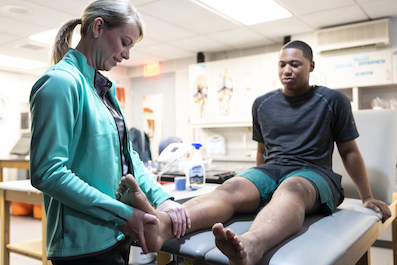 Cleanzine: your weekly cleaning and hygiene industry newsletter 3rd July 2025 Issue no. 1169
Cleanzine: your weekly cleaning and hygiene industry newsletter 3rd July 2025 Issue no. 1169
Your industry news - first
The original and best - for over 20 years!
We strongly recommend viewing Cleanzine full size in your web browser. Click our masthead above to visit our website version.
Infection control program reduces bacteria by 95% in athletic training rooms
 University Hospitals Sports Medicine researchers, in partnership with Gojo, found that an Infection Risk Reduction Program implemented in participating athletic training rooms reduced the overall amount of bacteria present by 95%, including completely eliminating the presence of influenza and multidrug-resistant organisms, such as MRSA.
University Hospitals Sports Medicine researchers, in partnership with Gojo, found that an Infection Risk Reduction Program implemented in participating athletic training rooms reduced the overall amount of bacteria present by 95%, including completely eliminating the presence of influenza and multidrug-resistant organisms, such as MRSA.
The study, published in the January 2020 issue of the American Orthopedic Society for Sports Medicine (AOSSM) national publication Sports Health, concluded that a program which modifies hygiene behaviour by connecting products, people and education can yield impactful infection control results and benefits.
The risk of athletes contracting multidrug-resistant infections from bacteria breeding in athletic training rooms is a real concern. Prior national studies of high school athletic training rooms have suggested over 40% of surfaces may be contaminated with Methicillin-resistant Staphylococcus aureus (MRSA).
"Our protocol was based upon principles used in the athletic training rooms in the National Football League and healthcare hygiene best practices," says co-author Mark LaBelle, MD, University Hospitals Orthopedic Surgery. “Our simplified protocol proved effective and provides a foundation for preventing infections in student-athletes at the collegiate and high school level not only locally, but across the country.”
The infection control program was piloted at two high schools and two colleges in Northeast Ohio, including Kent State University. Kent State Associate athletic director Trent Stratton notes that everything they do in their athletic training room revolves around the health & safety of student-athletes… "Even though we may think we're doing a good job keeping the facility clean, having the stats to support it is extremely beneficial," he says. “At the end of the day, an infection can destroy a season.”
Student-athletes are in close contact in the shared environment of an athletic training room, and in the presence of poor hygiene and contamination, can be exposed to a variety of germs that cause infection.
For the study, hand hygiene solutions (Purell Advanced Hand Sanitiser and Healthy Soap) and a broad-spectrum one-step surface disinfectant spray (Purell Professional Surface Disinfectant) were strategically placed throughout the athletic training rooms. Providing proven products and directing proper placement alone resulted in over 60% reduction in total bacteria.
After implementing a comprehensive solution that includes disinfectant products, protocols and educational resources, the participating athletic training rooms experienced a 95% reduction in total bacteria. Antibiotic-resistant bacteria, specifically MRSA and Vancomycin resistant enterococcus (VRE), which were found on 24% of surfaces in the training room at the beginning of the study, were eliminated by the end of the study. Additionally, influenza which was initially detected on 25% of the analysed surfaces, such as front door handles, drawer handles, water bottle lids and water cooler nozzles, was eliminated on surfaces sampled after implementation of the program.
Jim Arbogast, Ph.D., vice president, Hygiene Sciences and Public Health Advancements, Gojo - inventor of Purell hand sanitiser, says: "This study shows that the combination of targeted cleaning, ideal product placement, and simple education plus tools, along with the trusted strength of Purell products, can significantly reduce pathogens and the risk of infection among athletes and staff.
"Together, athletes, athletic trainers, athletic directors, and facility managers can sustain a safe environment, keeping athletes healthy and in the game. While this study looked at specific athletic training rooms, these same protocols can be applied beyond, into other areas of the athletic campus frequented by student-athletes, like locker rooms and weight rooms."
James Voos, MD, lead physician for the Cleveland Browns and Division Chief, UH Sports Medicine, adds: "This collaborative study between University Hospitals Sports Medicine and Gojo demonstrates how organizations committed to the health & safety of athletes can develop innovative, scientifically proven programs that can be practically applied to all sports and levels of competition, in particular close contact sports such as wrestling, hockey, gymnastics, soccer or football - where athletes experience greater incidence of infection."
Read the full study online at:
For infection prevention resources, including athlete infection prevention and cleaning checklists for optimal protection, and sport-specific athlete education posters, visit:
23rd January 2020







